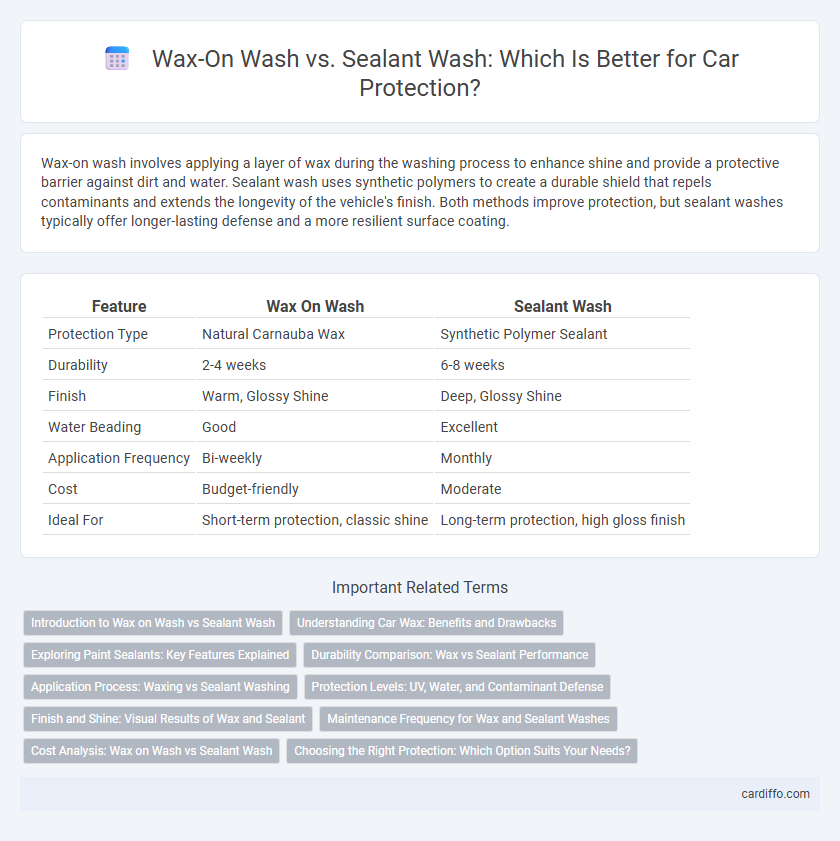Wax-on wash involves applying a layer of wax during the washing process to enhance shine and provide a protective barrier against dirt and water. Sealant wash uses synthetic polymers to create a durable shield that repels contaminants and extends the longevity of the vehicle's finish. Both methods improve protection, but sealant washes typically offer longer-lasting defense and a more resilient surface coating.
Table of Comparison
| Feature | Wax On Wash | Sealant Wash |
|---|---|---|
| Protection Type | Natural Carnauba Wax | Synthetic Polymer Sealant |
| Durability | 2-4 weeks | 6-8 weeks |
| Finish | Warm, Glossy Shine | Deep, Glossy Shine |
| Water Beading | Good | Excellent |
| Application Frequency | Bi-weekly | Monthly |
| Cost | Budget-friendly | Moderate |
| Ideal For | Short-term protection, classic shine | Long-term protection, high gloss finish |
Introduction to Wax on Wash vs Sealant Wash
Wax on wash involves applying a protective wax coating during the car wash process to enhance shine and add a layer of hydrophobic protection. Sealant wash uses synthetic polymers that bond to the vehicle's paint, providing longer-lasting protection against environmental contaminants and UV rays. Each method offers distinct advantages, with wax on wash focusing on immediate gloss and sealant wash emphasizing durable defense.
Understanding Car Wax: Benefits and Drawbacks
Car wax provides a protective layer that enhances shine and repels water, helping to maintain a vehicle's paintwork between washes. Wax-on washes deposit a thin layer of wax during cleaning, offering temporary protection but requiring frequent reapplication. Sealant washes, containing synthetic polymers, create a longer-lasting shield against contaminants and UV damage, though they may lack the deep gloss finish typical of natural waxes.
Exploring Paint Sealants: Key Features Explained
Paint sealants offer long-lasting protection by creating a durable, synthetic barrier on your car's surface, effectively repelling dirt, water, and contaminants compared to traditional wax. Unlike wax, which enhances shine and provides a natural finish but wears off faster, sealants maintain a glossy look for months and resist UV damage. Sealant washes often contain polymers that bond with the paint, ensuring enhanced durability and reduced need for frequent applications.
Durability Comparison: Wax vs Sealant Performance
Sealants generally offer superior durability compared to traditional waxes, lasting up to six months versus waxes that typically protect for 4 to 6 weeks. Sealants provide a stronger chemical barrier against environmental contaminants, UV rays, and water spots, ensuring prolonged protection and shine. Waxes, often made from natural carnauba or synthetic blends, deliver a warmer gloss but require more frequent application to maintain optimal defense.
Application Process: Waxing vs Sealant Washing
Wax on wash requires applying a layer of wax directly onto a clean, damp surface, allowing it to bond and form a protective film that enhances shine and water repellency. Sealant wash involves using a specially formulated wash containing sealant polymers that deposit a durable protective layer during the washing process, eliminating the need for separate application. Waxing demands more active buffing and curing time, while sealant washing simplifies maintenance by combining cleansing and sealing in one step, ideal for users seeking convenience and consistent protection.
Protection Levels: UV, Water, and Contaminant Defense
Wax on wash offers a natural barrier that excels in UV protection by reflecting harmful rays and providing a glossy finish, but its water resistance is moderate and may require frequent reapplications to maintain effectiveness. Sealant wash forms a denser, synthetic shield that provides superior water beading and longer-lasting defense against contaminants such as road grime and bird droppings, enhancing durability under harsh weather conditions. Protection levels against UV exposure, water repulsion, and contaminant defense are significantly higher with sealant wash compared to the organic composition of wax on wash.
Finish and Shine: Visual Results of Wax and Sealant
Wax on wash delivers a deep, glossy finish with rich reflections that enhance the paint's natural color and depth. Sealant wash provides a sleek, high-gloss shine with enhanced durability, creating a smoother, longer-lasting surface protection. The visual result of wax is often warmer and richer, while sealant offers a sharper, more reflective finish that resists environmental contaminants.
Maintenance Frequency for Wax and Sealant Washes
Wax washes typically require maintenance every 4 to 6 weeks due to their shorter durability against environmental contaminants. Sealant washes offer longer-lasting protection, with maintenance intervals extending up to 3 months, making them ideal for less frequent upkeep. Regular wax wash maintenance ensures optimal shine, while sealant washes focus on preserving surface protection over time.
Cost Analysis: Wax on Wash vs Sealant Wash
Wax on wash generally costs less upfront compared to sealant wash due to the lower price of wax products and simpler application process. Sealant wash, while pricier initially, offers longer-lasting protection that can reduce the frequency of treatments and overall maintenance expenses. Evaluating total cost over time, sealant wash often proves more cost-effective by extending vehicle shine and minimizing environmental damage.
Choosing the Right Protection: Which Option Suits Your Needs?
Wax on wash offers a natural, glossy finish by applying a layer of wax during the washing process, ideal for enhancing paint depth and providing moderate protection against dirt and UV rays. Sealant wash uses synthetic polymers to create a longer-lasting, more durable barrier against environmental contaminants, making it suitable for those seeking extended protection with less frequent applications. Selecting between wax on wash and sealant wash depends on your desired durability, ease of application, and the level of protection needed for your vehicle's paintwork.
Wax on wash vs Sealant wash Infographic

 cardiffo.com
cardiffo.com